(Da’n mej Del-geg-new-ol-tee-egg): How Unique We Still Are
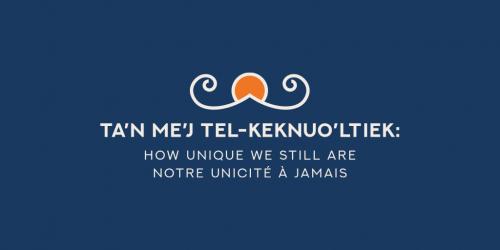
Mi’kmaw people past and present are shaped by their deep and abiding relations to the place they sprouted from. The Mi’kmaq continue to sprout from this land, to be nourished by these waters, to defend their inherent rights, and to respect treaty relationships with others in this place.
Ta'n me'j Tel-keknuo'ltiek: How Unique We Still Are, reflects how Mi’kmaw people remain connected to the lands and waters of Mi’kma’ki. This exhibit offers a platform for Mi’kmaw people to express their continued experiences with an understanding of the lands and the waters of Mi’kma’ki. Mi’kmaw single-word concepts are represented through personal testimony and histories of individual Mi’kmaw people, featured objects, artifacts, images and symbolic artwork. These experiences and understandings are rooted in cultural expressions that connect past, present and future in this place.
Ta'n me'j Tel-keknuo'ltiek: How Unique We Still Are offers the visitor, especially the non-Indigenous Canadian public, opportunities for fundamental treaty education, and to learn about the truths that must precede reconciliation.
This exhibit has been translated into Mi’kmaw using the Smith/Francis orthography. Throughout the translation process, the French and English versions have been changed as necessary to more accurately capture Mi’kmaw perception of the concepts presente
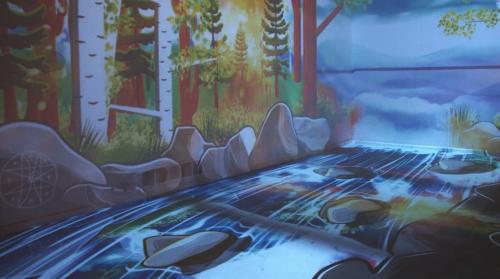
Image: Immersive exhibit entrance
Ta’n Me’j Tel-keknuo’ltiek: How Unique We Still Are is a remarkable exhibit that combines artwork, video, and personal experiences to share Mi’kmaw culture and Treaty Education.
Culture and language are closely braided. All text in Ta’n Me’j Tel-keknuo’ltiek is presented in three languages—Mi’kmaw, English, and French. Graphic designer Aaron Googoo’s beautiful illustrations depicting Mi’kmaw one-word concepts structure the exhibit. Through these concepts—Weji-sqalia’tiek, Netukulimk, Msit No’kmaq, and Siawa’sik—we gain insight into the nature of this land and our relations to it. This exhibit is based on the personal experiences of individual Mi’kmaw people, generously shared, and does not seek to represent broader communal voices. The words of those living in Mi’kma’ki today offer us insights into the range and diversity of Mi’kmaw people’s ways of living, working, and playing on the land and waters of this place.
We are all treaty people.
“…to share our culture, our spirituality, our customs, our traditions, our honour, our integrity: to be able to share that with settlers, that way we learn from each other.” –Debbie Eisan
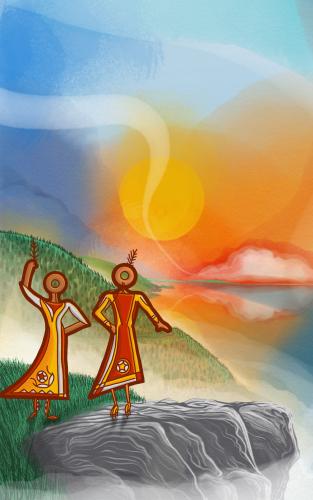
Image: Artwork by Aaron Googoo (Googoo Designs)
Weji-sqalia’tiek means “from where we sprouted”. Mi’kmaw people are shaped by their deep and abiding relations to the place they sprout from. Entering the exhibit, visitors walk through an immersive projection installation that depicts Mi’kma’ki ecosystems and wildlife. Birds fly through the woods; fish leap from the sea. Visitors are brought into the cultural legacy of these lands and waters.
“If you go out into the forest and you dig into the earth and you look at the roots: regardless of the species, they’re holding hands, all the roots are interwoven with each other and they’re holding each other up. It doesn’t matter if you’re a pine or ash or birch. They’re there as a community helping each other, and they’re strong that way.” –Melissa Labrador
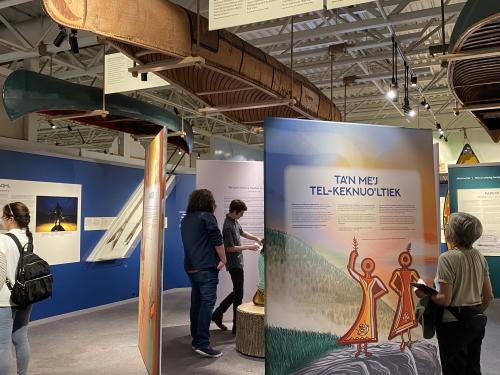
Image: Exhibit area and Treaty Education space
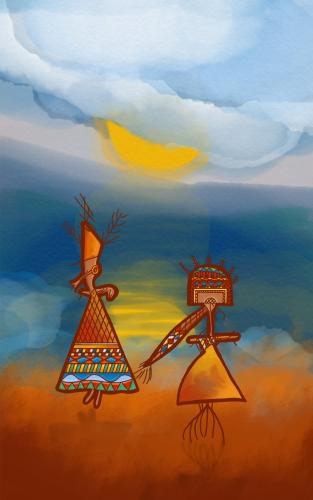
Image: Msit No’kmaq (Artwork by Aaron Googoo, Googoo Designs)
“All things on Mother Earth are connected. When we say Msit No’kmaq, it means 'all my relations'. It means 'all that is'. We are related to each other as brother and sisters, you know, we're also related to the four legged, flyers, swimmers, crawlers, the plants and trees, and the water.” –Dorene Bernard
In Mi’kmaw cultural understanding, people are not separate from these plants and animals, but deeply connected to them. “When we say Msit No’kmaq, it means ‘all my relations’. It means ‘all that is’.” This definition comes from Mi’kmaw water walker and land defender Dorene Bernard. Testimony and writing from Mi’kmaw community members, artists, and leaders fills the walls and panels of the Ta’n Me’j Tel-keknuo’ltiek gallery. Visitors learn about these concepts as expressed in first-person experience.
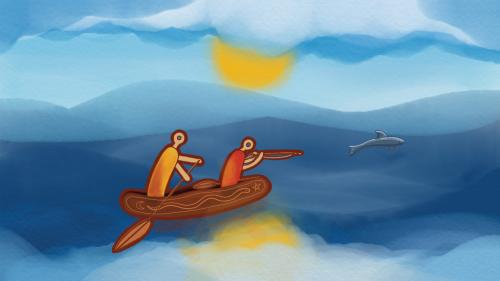
Image: Netukulimk (Artwork by Aaron Googoo, Googoo Design)
Netukulimk refers to bringing value into your life, supporting yourself and your family. The word instructs us to respect the earth, respect the water, to see it as a source of life. Netukulimk is about taking only what is sustainable. You cannot strip a forest, or overfish, or do things that would cause following generations to not have what we have. The exhibit brings visitors past the headlines and into an understanding of contemporary Mi’kmaw issues and experiences.
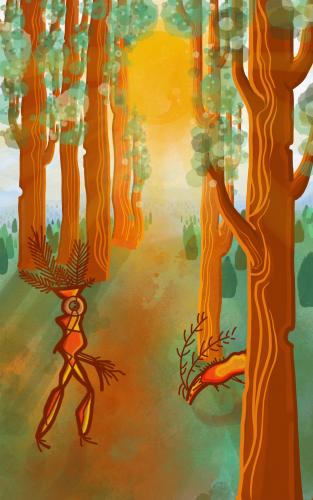
Image: Siawa’sik (Artwork by Aaron Googoo, Googoo Design)
Siawa’sik means continuation. The concept is key to understanding the truth necessary for reconciliation. The Mi’kmaq continue to sprout from this land, continue to be nourished by this land and these waters. The Mi’kmaq continue to adapt new knowledge and technologies to their present needs. The Mi’kmaq continue to defend the ecological integrity of these lands and these waters. They continue to protect them in the face of urgent environmental crises. Flags and signs from Mi’kmaw water warriors call visitors to action.
“Don't ever take truth away from the reconciliation. It's truth and reconciliation. It's not one or the other.” –Pamela Glode-Desrochers
The Ta’n Me’j Tel-keknuo’ltiek gallery is a special place to listen and reflect on the history and future of our region, and it provides important context for the stories told in our other galleries. Mi’kmaw maritime experience is also reflected in the Age of Steam gallery, showing a long history of shipbuilding and how it flourishes today in trades and apprenticeship programs, and the Navy gallery, which recognizes Mi’kmaw military experience and service with the Canadian Armed Forces.